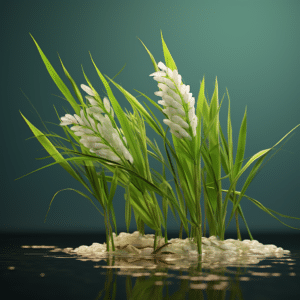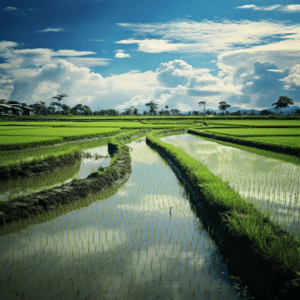Rice is one of the most important staple crops in the world, providing sustenance to billions of people. If you’re interested in growing rice yourself, this comprehensive guide will provide you with all the information you need to get started. From understanding the basics of rice cultivation to managing its growth and protecting your crops, we’ll cover everything step by step.
Understanding the Basics of Rice Cultivation

Growing rice starts with understanding the different types of rice you can grow and the ideal conditions for its growth.
Rice cultivation is a fascinating process that has been practiced for thousands of years. It is not only a staple food for millions of people around the world but also an integral part of their cultural heritage. To truly appreciate the art of rice cultivation, it is important to delve into the intricacies of different rice varieties and the optimal conditions required for their growth.
Types of Rice to Grow
There are thousands of rice varieties available, each with its own characteristics and growing requirements. From the slender and elongated grains of long-grain rice to the plump and sticky grains of short-grain rice, the diversity of rice is truly remarkable. Additionally, there are aromatic rice varieties that fill the air with a delightful fragrance when cooked.
Long-grain rice, as the name suggests, has grains that are long and slender. It is known for its fluffy texture and is commonly used in dishes like pilaf and biryani. Short-grain rice, on the other hand, has grains that are short and plump. This type of rice is stickier when cooked, making it perfect for sushi and risotto. Aromatic rice, such as Basmati and Jasmine, have a distinct fragrance that adds a delightful aroma to any meal.
When deciding which type of rice to grow, it is important to research different varieties and choose the one that suits your preferences and growing conditions. Consider factors such as taste, texture, cooking methods, and market demand to make an informed decision.
Ideal Conditions for Rice Growth
Rice thrives in warm, tropical climates with temperatures between 68°F and 104°F (20°C to 40°C). These regions provide the perfect environment for rice plants to flourish. The combination of warm temperatures, abundant sunlight, and ample water supply creates an ideal setting for rice cultivation.
One of the key factors in rice cultivation is water. Rice plants require a significant amount of water to grow properly. In fact, rice is often referred to as the “aquatic cereal” due to its affinity for water. Fields where rice is grown are often flooded with water, creating a unique and picturesque landscape. The flooded fields not only provide the necessary water for the plants but also help control weeds and pests.
Aside from water, rice plants also require plenty of sunlight to carry out photosynthesis, the process by which they convert sunlight into energy. The warm tropical climates where rice thrives ensure that there is an abundance of sunlight throughout the growing season.
Before embarking on rice cultivation, it is crucial to ensure that your region’s climate and available resources are suitable for growing rice. Factors such as temperature, rainfall, and access to water sources should be carefully considered. Additionally, it is important to assess the soil quality and make any necessary amendments to provide the optimal conditions for rice growth.
Understanding the basics of rice cultivation is just the beginning of a fascinating journey into the world of this ancient crop. From the diverse varieties to the intricate requirements, rice cultivation is a testament to the ingenuity and perseverance of farmers throughout history. So, whether you are a seasoned farmer or simply curious about the process, exploring the world of rice cultivation will undoubtedly leave you with a deeper appreciation for this humble grain.
Preparing the Field for Rice Planting

Before you can plant rice, you need to prepare the field properly. Let’s explore two key aspects of field preparation: choosing the right location and implementing effective soil preparation techniques.
Choosing the Right Location
When it comes to choosing the right location for rice cultivation, there are several factors to consider. Firstly, look for a flat or gently sloping area. This is important because rice fields need to be level to ensure proper water distribution during irrigation. If the field is too steep, water may accumulate in one area, leading to uneven growth and potential crop damage.
In addition to the topography, access to a reliable water source is crucial for successful rice cultivation. Rice thrives in flooded or paddy fields, so it’s important to consider the availability of water for irrigation purposes. A nearby river, lake, or well can provide the necessary water supply to keep the rice plants healthy and thriving.
Furthermore, it’s essential to avoid areas prone to strong winds or waterlogging. Strong winds can damage the delicate rice plants, especially during their early growth stages. On the other hand, waterlogging can suffocate the roots and hinder their ability to absorb nutrients effectively. By selecting a location shielded from strong winds and ensuring proper drainage, you can create an optimal environment for rice cultivation.
Soil Preparation Techniques
Now that you have chosen the right location, it’s time to focus on soil preparation techniques. The first step is to check the soil pH and fertility levels. Rice requires slightly acidic soil with a pH range of 5.0 to 7.0. Conducting a soil test will help you determine if any amendments, such as lime or organic matter, are needed to adjust the pH levels and improve the soil’s fertility.
Once you have assessed the soil’s pH and fertility, it’s time to prepare the field for planting. Start by using a plow or tractor to till the soil. This process helps break up any compacted soil and creates a loose and aerated environment for the rice roots to penetrate easily. Tilling also helps to incorporate any necessary amendments into the soil, ensuring that the rice plants have access to the nutrients they need for healthy growth.
During the tilling process, it’s important to remove any weeds or debris from the field. Weeds can compete with the rice plants for nutrients, water, and sunlight, hindering their growth. By clearing the field of weeds, you create a clean and favorable environment for the rice plants to flourish.
Lastly, ensure that the soil is well-drained. Rice plants require a sufficient amount of water for growth, but excessive water can be detrimental. Proper drainage allows excess water to flow out of the field, preventing waterlogging and ensuring that the rice plants receive the right amount of water for optimal growth.
In conclusion, preparing the field for rice planting involves carefully selecting the right location and implementing effective soil preparation techniques. By choosing a flat or gently sloping area with access to a reliable water source, and by tilling the soil, removing weeds, and ensuring proper drainage, you can create an ideal environment for successful rice cultivation.
The Rice Planting Process

Now that your field is ready, it’s time to plant the rice seeds. Understanding the optimal timing and techniques for rice planting is crucial for a successful crop.
When to Plant Rice
Rice is typically planted during the warmer months, when the soil temperature is above 50°F (10°C). The exact timing depends on your region and the rice variety you’ve chosen. Consult with local agricultural experts or use a planting calendar to determine the ideal planting time for your area.
How to Plant Rice Seeds
There are two main methods for planting rice seeds: dry seeding and wet seeding. Dry seeding involves broadcasting the seeds directly onto the field and then flooding the field, while wet seeding involves pre-germinating the seeds and transplanting them into the flooded field. Choose the method that suits your farming practices and the specific type of rice you’re growing.
Managing Rice Growth
Once your rice crop is established, it’s essential to manage its growth effectively to maximize productivity and minimize risks.
Watering and Irrigation Methods
Rice requires a consistent water supply throughout its growth cycle. Depending on your water resources, you can opt for traditional flooding methods or adopt more efficient irrigation systems such as drip irrigation. Monitor soil moisture levels regularly and adjust the irrigation schedule accordingly to prevent overwatering or drought stress.
Fertilization and Nutrient Management
Applying fertilizers and managing nutrients is crucial for healthy rice growth. Conduct a soil test to determine the nutrient requirements and apply fertilizers accordingly. Nitrogen, phosphorus, and potassium are the primary nutrients needed by rice. Consider using organic fertilizers or implementing nutrient management practices to minimize environmental impact.
Protecting Your Rice Crop
As with any crop, rice is susceptible to pests and diseases that can significantly impact yield and quality. Learning about common rice pests and diseases and adopting appropriate control methods is key to safeguarding your crop.
Common Pests and Diseases
Rice pests include insects like rice stem borers, leafhoppers, and armyworms, as well as diseases like blast and sheath blight. Recognizing the symptoms and understanding the life cycles of these pests and diseases will help you implement timely control measures.
Organic and Chemical Control Methods
Controlling pests and diseases can be achieved through both organic and chemical methods. Organic control methods include crop rotation, biological control agents, and resistant rice varieties. Chemical control methods involve the use of pesticides following proper safety guidelines. It’s essential to understand the risks and benefits of each method and choose the most appropriate one for your specific situation.
By following this comprehensive guide, you’ll have a solid foundation for successfully growing rice. Remember, patience and adaptability are key when it comes to agriculture. Monitor your crops regularly, make adjustments as necessary, and enjoy the journey of cultivating this vital crop.